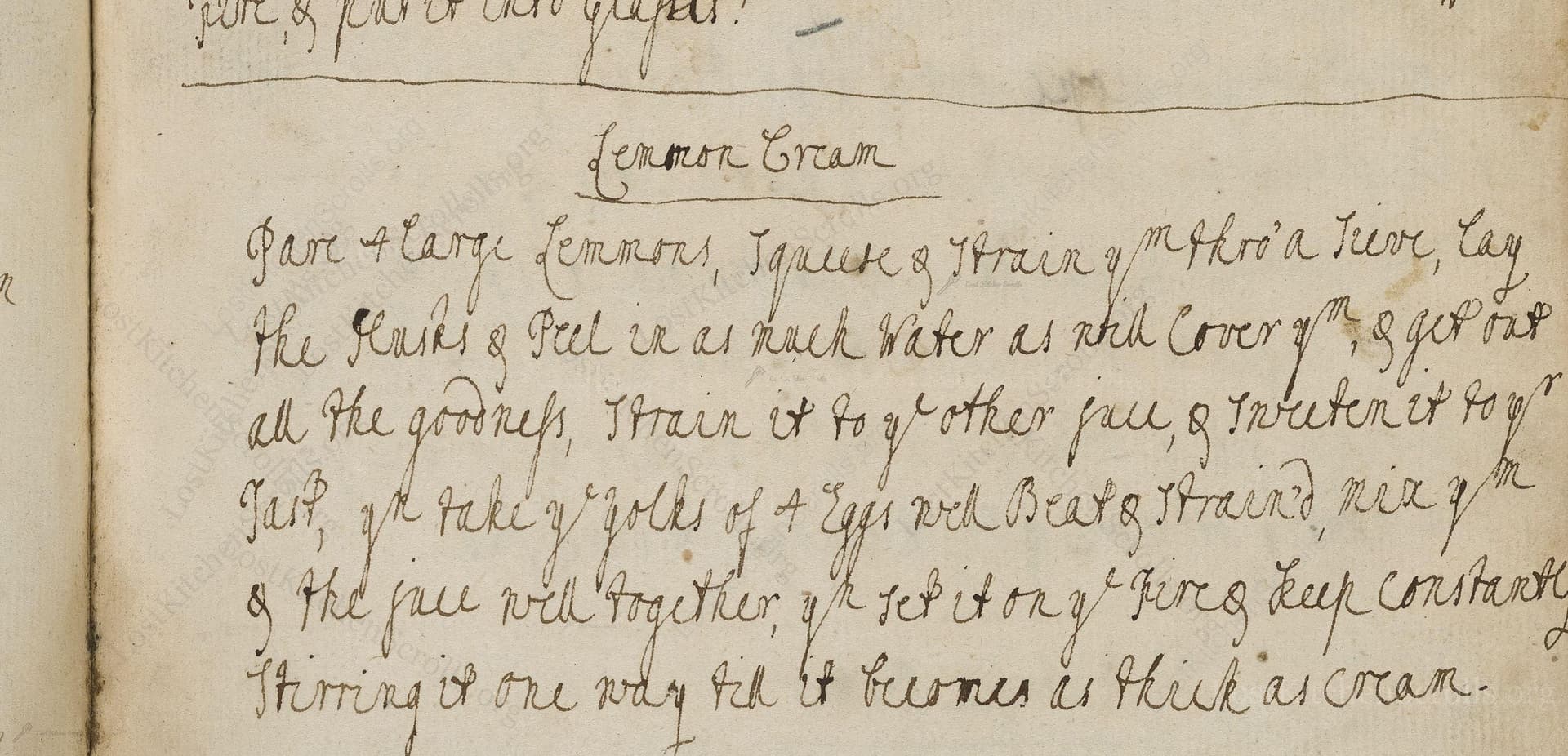Lemmon Cream
From the treasured pages of Receipt book of Elizabeth Smith
Written by Elizabeth Smith

Lemmon Cream
"Pare 4 Large Lemmons, Squeese yr Juce & Strain yr The Rinds & Peel in as much Water as will Cover ym & get out all the goodness, Strain it to yr other Juce, & Sweeten it to yr Tast, yr take yr yolks of 4 Eggs & the Juce well Beat & Strain'd, mix ym & the juce well together, yr set it on yr Fire & keep constantly Stirring it one way till it becomes as thick as Cream."
Note on the Original Text
The recipe is written in typical 18th-century English, using period abbreviations such as 'yr' for 'your' and 'ym' for 'them.' Instructions are direct but assume culinary knowledge—such as knowing how to temper eggs or judge the thickness of a cream. Spelling is somewhat phonetic and grammar fluid, reflecting how recipes were passed between families for personal use rather than formal publication. Modern readers may note that the process combines elements of citrus infusion with custard making, relying on careful handwork and attention.

Title
Receipt book of Elizabeth Smith (1775)
You can also click the book image above to peruse the original tome
Writer
Elizabeth Smith
Era
1775
Publisher
Unknown
Background
Step into the refined kitchens of the late 18th century with Elizabeth Smith, whose culinary wisdom offers a charming taste of Georgian elegance and time-honored recipes to delight any palate.
Kindly made available by
Folger Shakespeare Library
This delightful Lemmon Cream recipe is drawn from the manuscript collection of Elizabeth Smith, an English woman active between 1749 and 1800. During this period, lemony desserts and creams were fashionable at Georgian tables, showcasing both the influence of the expanding global trade—lemons were a prized import—and the evolving art of English puddings and custards. Recipes like this would have featured in genteel households and were prized for their bright, refreshing flavor, ideal for finishing a rich meal.

Back in the eighteenth century, this recipe would have been prepared using a small copper or earthenware saucepan, a wooden spoon for stirring, and a fine cloth or sieve for straining juice and infused water. Lemons would be peeled with a small paring knife. The egg yolks would be beaten with a fork or wooden whisk, and the cream cooked gently over an open hearth or stove—constant attention was necessary to prevent curdling.
Prep Time
15 mins
Cook Time
15 mins
Servings
4
We've done our best to adapt this historical recipe for modern kitchens, but some details may still need refinement. We warmly welcome feedback from fellow cooks and culinary historians — your insights support the entire community!
Ingredients
- 4 large lemons (about 10-12 oz total weight)
- 7 fl oz water (enough to cover lemon rinds)
- 4 egg yolks (large eggs, about 3 oz yolk)
- 1/2 to 3/4 cup granulated sugar (adjust to taste)
Instructions
- Begin by peeling four large lemons, ensuring to remove only the rind and as little of the bitter white pith as posible.
- Squeeze the juice from the lemons and strain it to remove seeds and pulp.
- Place the peeled rinds in a saucepan and cover them with just enough water to submerge.
- Gently simmer the rinds for about 10 minutes to extract their flavor, then strain this liquid and combine it with the strained lemon juice.
- Sweeten the mixture to your taste with granulated sugar.
- Separate the yolks from 4 eggs, then beat them well.
- Gradually mix the beaten yolks into the slightly cooled lemon juice mixture, whisking constantly.
- Return everything to a gentle heat, stirring continuously in one direction, until the mixture thickens to the consistency of pouring cream (about 160°F, or until it coats the back of a spoon).
- Remove from heat and let cool before serwing.
Estimated Calories
130 per serving
Cooking Estimates
Preparing the lemons and eggs takes about 15 minutes, while simmering the rinds and gently thickening the custard takes about 15 more minutes. Each serving has about 130 calories, based on dividing the finished lemon custard into four portions.
As noted above, we have made our best effort to translate and adapt this historical recipe for modern kitchens, taking into account ingredients nowadays, cooking techniques, measurements, and so on. However, historical recipes often contain assumptions that require interpretation.
We'd love for anyone to help improve these adaptations. Community contributions are highly welcome. If you have suggestions, corrections, or cooking tips based on your experience with this recipe, please share them below.
Join the Discussion
Rate This Recipe
Dietary Preference
Main Ingredients
Culinary Technique
Occasions

Den Bockfisch In Einer Fleisch Suppen Zu Kochen
This recipe hails from a German manuscript cookbook compiled in 1696, a time whe...

Die Grieß Nudlen Zumachen
This recipe comes from a rather mysterious manuscript cookbook, penned anonymous...

Ein Boudain
This recipe comes from an anonymous German-language manuscript cookbook from 169...

Ein Gesaltzen Citroni
This recipe, dating from 1696, comes from an extensive anonymous German cookbook...
Browse our complete collection of time-honored recipes



